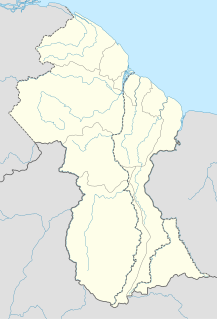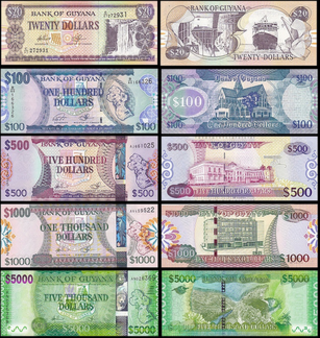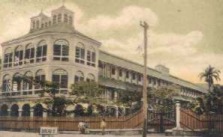 W
WThe Berbice slave uprising was a slave revolt in Guyana that began on 23 February 1763 and lasted to December, with leaders including Coffy. It is seen as a major event in Guyana's anti-colonial struggles, and when Guyana became a republic in 1970 the state declared 23 February as a day to commemorate the start of the Berbice slave revolt.
 W
WBorsselen is an island in the Demerara River of Guyana, and was the capital of Demerara between 1755 and 1782.
 W
WBritish Guiana was a British colony, part of the British West Indies, which resided on the northern coast of South America, now known as the independent nation of Guyana since 1966.
 W
WBritish Guiana at the 1930 British Empire Games was represented by a total of seven athletes.
 W
WCuffy, also spelled as Kofi or Koffi, was an Akan man who was captured in his native West Africa and stolen for slavery to work on the plantations of the Dutch colony of Berbice in present-day Guyana. He became famous because in 1763 he led a revolt of more than 2,500 slaves against the colony regime. Today, he is a national hero in Guyana.
 W
WCummingsburg, or historically Cumingsburg, is a ward in Georgetown, Guyana. It began as 500-acre plantation, La Bourgade about 1759. When Thomas Cumming, a Scotsman, bought the property, he developed a town plan with residential and commercial lots and streets. The town layout was modified after a fire that burnt much of the town in 1864. Today, it is the site of several museums, including a national and anthropological museum.
 W
WThe Cuyuni River is a South American river and a tributary of the Essequibo River. It rises in the Guiana Highlands of Venezuela, where it descends northward to El Dorado, and turns eastward to meander through the tropical rain forests of Guyana. It finally turns southeastward, flowing to its confluence with the Mazaruni River. The Cuyuni River marks the limit of the disputed territory of Guyana Essequibo for approximately 100 kilometres (62 mi).
 W
WDemerara is a historical region in the Guianas on the north coast of South America which is now part of the country of Guyana. It was a Dutch colony until 1815 and a county of British Guiana from 1838 to 1966. It was located about the lower courses of the Demerara River, and its main town was Georgetown.
 W
WThe Demerara rebellion of 1823 was an uprising involving more than 10,000 slaves that took place in the colony of Demerara-Essequibo (Guyana). The rebellion, which began on August 18, 1823, and lasted for two days, was led by slaves with the highest status. In part they were reacting to poor treatment and a desire for freedom; in addition, there was a widespread, mistaken belief that Parliament had passed a law for emancipation, but it was being withheld by the colonial rulers. Instigated chiefly by Jack Gladstone, a slave at "Success" plantation, the rebellion also involved his father, Quamina, and other senior members of their church group. Its English pastor, John Smith, was implicated.
 W
WThe colony of Demerara-Essequibo was created on 28 April 1812, when the British combined the colonies of Demerara and Essequibo into the colony of Demerara-Essequibo. They were officially ceded to Britain on 13 August 1814. On 20 November 1815 the agreement was ratified by the Netherlands.
 W
WThe capture of Demerara and Essequibo was a French military expedition carried out in January 1782 as part of the American Revolutionary War. In 1781, Admiral Lord Rodney sent two sloops from his fleet at Sint Eustatius to take possession of the Dutch colonies of Essequibo and Demerara. In 1782, the French successfully took possession of these settlements, compelling British Governor Robert Kinston to surrender. The Peace of Paris, which occurred in 1783, restored these territories to the Dutch.
 W
WThe Discovery of Guiana is a book by Sir Walter Raleigh, who wrote this account one year after his 1595 journey to "Guiana", the Venezuelan region of Guayana. He also visited Trinidad. The book includes some material of a factual nature, but postulates the existence of a gold-rich civilisation on the basis of little evidence.
 W
WFort Kyk-Over-Al was a Dutch fort in the colony of Essequibo, in what is now Guyana. It was constructed in 1616 at the intersection of the Essequibo, Cuyuni and Mazaruni rivers. It once served as the centre for the Dutch administration of the county, but now only ruins are left. The name Kyk-Over-Al derives from the Dutch for "See over all", a reference to the commanding view of the river from the fort.
 W
WFort Nassau was the capital of the Dutch colony of Berbice, in present-day Guyana. It was situated on the Berbice River approximately 88 kilometres upstream from New Amsterdam.
 W
WThe Georgetown Lighthouse was first built by the Dutch in 1817 and then rebuilt in 1830 to help guide ships into the Demerara River from the Atlantic Ocean. The 31 m (103 feet) high octagonal structure is a famous Georgetown, Guyana landmark with its distinct vertical red and white stripes. The Lighthouse, located on Water Street, is maintained by the National Trust of Guyana.
 W
WGeorgetown is a city and the capital of Guyana, located in Region 4, which is also known as the Demerara-Mahaica region. It is the country's largest urban centre. It is situated on the Atlantic Ocean coast at the mouth of the Demerara River and it was nicknamed the "Garden City of the Caribbean."
 W
WGuayana Province (1585−1864) was a former province of Spanish Colonial Venezuela and independent Venezuela, located in the Guyana region of northeastern South America.
 W
WThe Guianas, sometimes called by the Spanish loan-word Guayanas, is a region in north-eastern South America which includes the following three territories:French Guiana, an overseas department and region of France. Guyana, formerly known as British Guiana from 1831 until 1966, after the colonies of Berbice, Essequibo, and Demerara, taken from the Netherlands in 1814, were merged into a single colony. Suriname, formerly Dutch Guiana, until 1814 together with Berbice, Essequibo and Demerara.
 W
WThe Guyanese dollar has been the unit of account in Guyana since 29 January 1839. Originally it was intended as a transitional unit to facilitate the changeover from the Dutch guilder system of currency to the British pound sterling system. The Spanish dollar was already prevalent throughout the West Indies in general, and from 1839, the Spanish dollar unit operated in British Guiana in conjunction with British sterling coins at a standard conversion rate of one dollar for every four shillings and twopence. In 1951 the British sterling coinage was replaced with a new decimal coinage which was simultaneously introduced through all the British territories in the Eastern Caribbean. When sterling began to depreciate in the early 1970s, a switch to a US dollar peg became increasingly attractive as an anti-inflationary measure and the Eastern Caribbean Currency Authority made the switch in October 1975. The Guyanese dollar is normally abbreviated with the dollar sign $, or alternatively G$ to distinguish it from other dollar-denominated currencies.
 W
WJames Warren Jones was an American cult leader, preacher and self-professed faith healer. He launched the Peoples Temple in Indiana during the 1950s. Jones and his inner circle orchestrated a mass murder-suicide of himself and his followers in his jungle commune at Jonestown, Guyana on November 18, 1978.
 W
WThe Peoples Temple Agricultural Project, better known by its informal name "Jonestown", was a remote settlement in Guyana, established by the Peoples Temple, a San Francisco-based cult under the leadership of Jim Jones.
 W
WLake Parime or Lake Parima is a legendary lake located in South America. It was reputedly the location of the fabled city of El Dorado, also known as Manoa, much sought-after by European explorers. Repeated attempts to find the lake failed to confirm its existence, and it was dismissed as a myth along with the city. The search for Lake Parime led explorers to map the rivers and other features of southern Venezuela, northern Brazil, and southwestern Guyana before the lake's existence was definitively disproved in the early 19th century. Some explorers proposed that the seasonal flooding of the Rupununi savannah may have been misidentified as a lake. Recent geological investigations suggest that a lake may have existed in northern Brazil, but that it dried up some time in the 18th century. Both "Manoa" and "Parime" are believed to mean "big lake".
 W
WAdmiral Sir David Milne of Milne Graden GCB FRSE RN was a Scottish Royal Navy admiral.
 W
WNew Amsterdam Public Hospital, in New Amsterdam, Guyana, is outstanding example of timber architecture, and one of the two surviving architectural masterpieces designed by Cesar Castellani, an architect employed in the Public Works Department of British Guiana.
 W
WNew Amsterdam is one of the largest towns in Guyana, located in the East Berbice-Corentyne Region, 100 kilometres (62 mi) from the capital, Georgetown. It is located on the eastern bank of the Berbice River, 6 km (4 mi) upriver from its mouth at the Atlantic Ocean, and immediately south of the Canje River. It is the regional capital of East Berbice-Corentyne. New Amsterdam's population is 17,329 inhabitants as of 2012.
 W
WNew Andalusia Province or Province of Cumaná (1537–1864) was a province of the Spanish Empire, and later of Gran Colombia and Venezuela. It included the territory of present-day Venezuelan states Sucre, Anzoátegui and Monagas. Its most important cities were the Capital City Cumaná and New Barcelona.
 W
WThe New Kingdom of Granada, or Kingdom of the New Granada, was the name given to a group of 16th-century Spanish colonial provinces in northern South America governed by the president of the Audiencia of Santa Fe, an area corresponding mainly to modern-day Colombia. The conquistadors originally organized it as a captaincy general within the Viceroyalty of Peru. The crown established the audiencia in 1549. Ultimately the kingdom became part of the Viceroyalty of New Granada first in 1717 and permanently in 1739. After several attempts to set up independent states in the 1810s, the kingdom and the viceroyalty ceased to exist altogether in 1819 with the establishment of the United Provinces of New Granada.
 W
WThe Parliament Building houses the National Assembly of Guyana, and is located in the capital Georgetown. The building was designed by Joseph Hadfield, and is located in Brickdam where the Court of Policy used to be. The building was completed on 21 February 1834. The Parliamentary Chamber contains a decorated ceiling designed by Cesar Castellani.
 W
WThe President of the Co-operative Republic of Guyana is the head of state and the head of government of Guyana, as well as the commander-in-chief of the armed forces of the Republic, according to the Constitution of Guyana. The president is also the chancellor of the Orders of Guyana.
 W
WQuamina Gladstone, most often referred to simply as Quamina, was a Guianese slave, a Coromantee, who was father of Jack Gladstone. He and his son were involved in the Demerara rebellion of 1823, one of the largest slave revolts in the British colonies before slavery was abolished.
 W
WSir Walter Raleigh , also spelled Ralegh, was an English landed gentleman, writer, poet, soldier, politician, courtier, spy and explorer. He was a cousin of Sir Richard Grenville and younger half-brother of Sir Humphrey Gilbert. He is also well known for popularising tobacco in England. Raleigh was one of the most notable figures of the Elizabethan era.
 W
WGuayana Province (1585−1864) was a former province of Spanish Colonial Venezuela and independent Venezuela, located in the Guyana region of northeastern South America.
 W
WStabroek was the old name of Georgetown, Guyana, between 1784 and 1812, and was the capital of Demerara. Stabroek is currently a ward in the centre of Georgetown.
 W
WSS Sutlej was a 3,549 ton steamship built for the Nourse Line in about 1907 by Charles Connell & Company Limited, Glasgow. She had single screw, triple expansion, 425 horsepower (317 kW) engines.
 W
WThe Viceroyalty of New Granada was the name given on 27 May 1717, to the jurisdiction of the Spanish Empire in northern South America, corresponding to modern Colombia, Ecuador, and Venezuela. Created in 1717 by king Felipe V, inside of a new territorial control policy, it was suspended in 1723 due to financial problems and was restored in 1739 until the independence movement suspended it again in 1810. The territory corresponding to Panama was incorporated later in 1739, and the provinces of Venezuela were separated from the Viceroyalty and assigned to the Captaincy General of Venezuela in 1777. In addition to these core areas, the territory of the Viceroyalty of New Granada included Guyana, southwestern Suriname, parts of northwestern Brazil, and northern Peru.
 W
WVictoria is located on the Atlantic coast of Guyana, 29 kilometres (18 mi) east of Georgetown and bordered by Cove and John to the west and Belfield to the east. It was the first village in Guyana to be bought by the combined resources of Africans who had recently won their freedom from slavery.
 W
WCharles Waterton was an English naturalist and explorer. He is best known as a pioneering conservationist.
 W
WWerk-en-rust, also Werken-Rust, is a ward in Georgetown, Guyana, located along the Demerara River that feeds into the Atlantic Ocean.